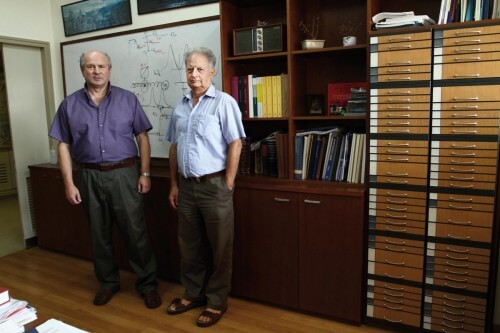Rotating objects have a property called angular momentum, which measures their tendency to continue rotating.

Several spinning tops spinning in close proximity will collide with each other in a short time and stop spinning. But according to the laws of physics, if many pinwheels rotate together, in exactly the same way, and at a very high speed, another phenomenon will occur, in the first stage: they may enter into a common and uniform rotational movement around a central point. The attempt to create this phenomenon using vortices is impractical, but a study by scientists from the Weizmann Institute of Science shows that it is possible to do this when the place of the vortices is filled by gas molecules. Such a rotating flow of molecules - a kind of vortex of gas - may have several applications in biomedicine and nanoscience.
Rotating objects have a property called angular momentum, which measures their tendency to continue rotating. Several years ago, Prof. Ilya Aberbuch and Prof. Yachiam Pryor, and the members of their groups from the Department of Chemical Physics in the Faculty of Chemistry at the Weizmann Institute of Science, proposed that it is possible to influence the angular momentum of molecules by means of very short impulses (pulses) of laser beams. In Prof. Pryor's laboratory, lasers are used that "shoot" impulses that are no longer than 50 femtoseconds (a femtosecond is one millionth of a billionth of a second). These short laser pulses cause groups of molecules to rotate in one direction.
Research student Uri Steinitz, from Prof. Aberbuch's group, wanted to know what happens next, when the rotational movement continues: do the molecules collide with each other, like spinning tops, and if so, how does this affect their rotation? The laws of physics state that the angular momentum is always conserved in the system. When the rotating molecules collide with each other, their rotation speed decreases, and the rotation axis becomes random. Still, the total angular momentum of all of them should be conserved. The question is: where exactly?
To find out the answer to this, the scientists used a system of compressed gas, where all the molecules rotate in one direction, and calculated what happens when the molecules go back and collide with each other.
Thus it became clear that after a certain number of collisions, the angular momentum of individual molecules was "lost", but it "reappeared" in the system, on a larger scale: the gas molecules in the system began to rotate together in a vortex around a central point. The size of the vortex may exceed a million times that of a single molecule, and its rate may theoretically reach tens or even hundreds of thousands of revolutions per second. While the angular momentum gradually dissipated within the system, repeated pulses of laser beams managed to maintain the stirring motion of the gas.
These findings illustrate a principle that is usually observed in much larger systems: strong storms, such as cyclones, start as a series of small eddies, collide with each other, and accumulate into a large, uniform vortex.
Molecular vortices may be useful as a means of controlling various particles. As a vortex spins, its momentum pulls nearby molecules into its path. It is perhaps possible to use this feature as a device to move small particles (such as biological molecules, whose direct movement by means of a laser beam may harm them), without touching them directly. In addition, in the future it may be possible to operate microfluidic devices, which are used in biomedical research and the pharmaceutical industry.


6 תגובות
And by God, a great engine, a thousand revolutions per second engine...
I never noticed, interesting…
It is important to clarify, I am not a chemist and I am not a physicist, the following explanation is for my humble opinion only:
Is the pan straight, are there differences in height? Temperature differences between the different points on the face of the pan?
Probably so..
If the oil boils at the exact same temperature and at the exact same height/thickness at each and every point and the drop of water is also symmetrical and not spread in some asymmetrical way on top of the pan (which must be straight and have the same temperature for its entire area)...
I see no reason for a spiral wave
Only a lack of symmetry between the various points in the pan/oil/water will produce a wave that is not a symmetrical circle.
Since there is a sea of effects on the space of the oil and water (except for what I mentioned there is also minimal dirt/oxygen/wind/who knows what else) I assume that only in the laboratory will it be possible to know if the phenomenon you mentioned exists.
Mr. Editor, perhaps someone can explain the following phenomenon: when you pour a little oil into a pan and let it heat up, what happens is small "explosions" that can be explained in reality as water vapor on the surface of the bottom of the pan or inside the oil. But why are the short waves spiral?
I have a piece of back huh? (-:
To the believer you are not alone, Einstein also believed in a deterministic world.
How cool that what works big also works small...
I bet (because I'm afraid to use the word "believer" here)
that at some point it will become clear that the quanta, and even what is beyond them, behave similarly to the nature we know and not according to some wheel of fortune.